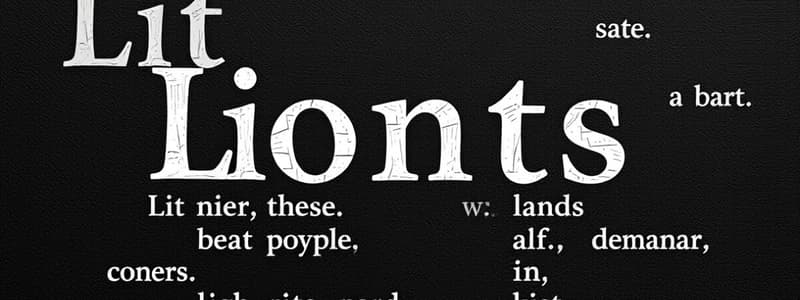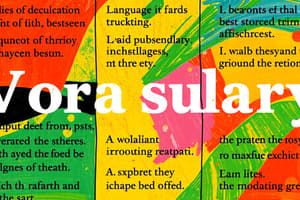Podcast
Questions and Answers
What is alliteration?
What is alliteration?
- The repetition of a beginning consonant sound within a phrase or sentence (correct)
- An expression that cannot be understood if taken literally
- A struggle between two opposing forces
- A comparison without using like or as
What is an allusion?
What is an allusion?
A direct or indirect reference to another work of literature, person, or event
What is an antagonist?
What is an antagonist?
A character or force in conflict with the main character
What is characterization?
What is characterization?
What is climax in a story?
What is climax in a story?
What is conflict?
What is conflict?
What is connotation?
What is connotation?
What is euphemism?
What is euphemism?
What is foreshadowing?
What is foreshadowing?
What is genre?
What is genre?
What is hyperbole?
What is hyperbole?
What is an idiom?
What is an idiom?
What is imagery?
What is imagery?
What is irony?
What is irony?
What is metaphor?
What is metaphor?
What is onomatopoeia?
What is onomatopoeia?
What is an oxymoron?
What is an oxymoron?
What is personification?
What is personification?
What is plot?
What is plot?
What is point of view?
What is point of view?
What is a protagonist?
What is a protagonist?
What is pun?
What is pun?
What is simile?
What is simile?
What is setting?
What is setting?
What is a symbol?
What is a symbol?
What is theme?
What is theme?
Study Notes
Language Arts Terms and Definitions
-
Alliteration: Repetition of the same beginning consonant sound in a series of words or phrases, enhancing rhythm and focus.
-
Allusion: A reference that can be direct or indirect to another literary work, historical figure, event, or cultural element, enriching the text's meaning.
-
Antagonist: The character or force that opposes the main character, creating conflict and driving the narrative.
-
Characterization: Methods employed to reveal a character's attributes, either directly through description or indirectly through actions and dialogue.
-
Climax: The peak of a plot where emotional intensity, suspense, or interest is at its highest, usually coinciding with the resolution of the central conflict.
-
Conflict: The clash between opposing forces that motivates the action and development of the story, often categorized into internal and external types.
-
Connotation: The array of meanings, emotions, and associations linked to a word beyond its literal definition.
-
Euphemism: A polite or less abrasive term substituted for one that may be considered harsh or blunt.
-
Foreshadowing: A literary device that hints at events to come, allowing for deeper understanding once those events unfold.
-
Genre: Categories of literature or art defined by shared traits, styles, or themes, such as fiction, poetry, drama, etc.
-
Hyperbole: Exaggeration used for emphasis or effect, often found in speech and literature to create a strong impression.
-
Idiom: A phrase whose meaning is not predictable from the literal meanings of its individual words, reflecting cultural nuances.
-
Imagery: Descriptive language that engages the sensory experiences (sight, sound, smell, touch, taste) of the reader.
-
Irony: A literary technique highlighting the difference between appearance and reality, often creating humor or drama.
-
Metaphor: A direct comparison that asserts one thing as being another, providing deeper meaning and insight.
-
Onomatopoeia: Words that phonetically imitate the sound they describe, enhancing sensory engagement in writing.
-
Oxymoron: A figure of speech that juxtaposes contradictory terms to reveal a complex truth or idea.
-
Personification: Attributing human traits and qualities to non-human entities or inanimate objects, deepening relatability.
-
Plot: The structured sequence of events that constitute a narrative, revealing how conflicts unfold and resolve.
-
Point of View: The vantage point from which the story is conveyed, influencing the reader's perception and connection to the narrative.
-
Protagonist: The central character around whom the narrative revolves, often facing challenges and undergoing change.
-
Pun: A play on words that exploits multiple meanings for humor or rhetorical effect.
-
Simile: An explicit comparison between two different things using "like" or "as" to create vivid imagery.
-
Setting: The backdrop against which the story takes place, including specific locations, historical periods, and cultural contexts.
-
Symbol: An object, character, or event that represents a deeper, often abstract meaning, enriching the narrative.
-
Theme: The overarching topic or underlying message in a literary work, catering to broad ideas that resonate throughout the text.
Studying That Suits You
Use AI to generate personalized quizzes and flashcards to suit your learning preferences.
Description
Test your knowledge of essential language arts vocabulary with these flashcards. Explore terms such as alliteration, allusion, and characterization, and deepen your understanding of literary concepts and their applications.




